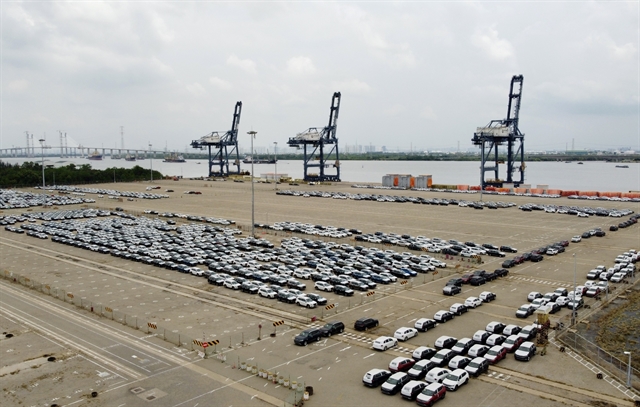.jpg) Economy
Economy

 |
| Imported cars at Sài Gòn Port. The imports accounted for 68,280 units sold in the first five months - up 29 per cent year-on-year, outpacing the 13 per cent growth of locally assembled cars. — VNA/VNS Photo Trung Tuyến |
HÀ NỘI — Việt Nam’s automotive market is seeing a strong inflow of imported vehicles, with the total value of completely built-up (CBU) auto imports surpassing US$2 billion as of mid-June.
However, amid rising supply and stagnant demand, the industry is facing continued inventory pressure and widespread price cuts.
Data from the General Department of Customs shows that 96,264 CBU vehicles were imported into Việt Nam from January to June 15, with a total value exceeding $2 billion. In the first half of June alone, more than 12,200 vehicles worth $253 million entered the country.
This represents a significant year-on-year increase in both volume and value, confirming a continuing consumer shift towards imported cars. According to the Việt Nam Automobile Manufacturers’ Association (VAMA), imports accounted for 68,280 units sold in the first five months - up 29 per cent year-on-year, outpacing the 13 per cent growth of locally assembled cars.
Despite the increasing import numbers, Việt Nam’s auto market is facing a growing imbalance between supply and demand.
Figures from the General Statistics Office estimate that around 56,200 new vehicles (both imported and domestically assembled) were added to the market in May alone, slightly down 0.7 per cent from April. Total production by local manufacturers reached approximately 183,400 units in the first five months of 2025, a sharp 70.3 per cent increase compared to the same period in 2024.
At the same time, imported vehicle volume in the first five months hit 84,045 units, up 43.3 per cent. This means that by the end of May, a combined total of 267,400 new cars had been added to the market.
However, only 207,000 units were sold in the same period, leaving an estimated 60,000 unsold cars, twice the total number of VAMA member sales in May (29,210 units). Inventory build-up has persisted since 2024, when oversupply exceeded 110,000 vehicles.
With the market yet to rebound decisively, manufacturers and dealers have continued to offer steep discounts and incentives to clear out older inventory, including many 2024-model vehicles still on showroom floors, and in some cases, even 2023 units.
This price-cutting wave has affected all segments from Japanese and South Korean brands to Chinese and European models. Analysts expect the situation to continue through the Ghost Month (August), a traditional low season for car sales in Việt Nam.
US imports see hope in tariff talks, but still face hurdles
Amid this challenging backdrop, trade negotiations between Việt Nam and the US have raised expectations of a potential zero import tariff on American-made vehicles. Such a move could lower prices and increase competitiveness for US brands.
Industry experts say the impact may be limited.
Trần Thúy Hằng, an import specialist, told online newspaper Vietnamnet.vn that even with a zero per cent import tariff, US cars will still be more expensive due to high shipping and insurance costs compared to ASEAN models.
Take the Jeep Wrangler, for example. With a CIF price of over $75,000, its post-tax retail price in Việt Nam would still be around VNĐ3.2 billion, only 13–15 per cent lower than current prices.
Ford Explorer and Mercedes-Benz GLE, both imported from the US, may benefit more. Price reductions of up to 20 per cent could save consumers hundreds of millions of đồng, potentially enhancing their appeal in the SUV and luxury segments. Still, overall market impact is expected to remain small in the short term, as most US imports are limited in volume and lie in premium categories.
Longer-term, the presence of more competitive American vehicles could add diversity and increase pressure on other importers and local assemblers, especially as new models and brands enter the scene.
June saw the arrival of several new models, including the Isuzu mu-X 2025, BMW X5 and 5 Series, Hyundai Creta 2025, Tucson N Line and possibly the Suzuki Swift 2025 and Skoda Kushaq. These launches are expected to refresh customer interest and may help absorb some of the excess supply.
For now, however, experts agree that the ongoing oversupply and lukewarm demand will likely prolong the current price war well into the second half of the year. — VNS



.jpg)
